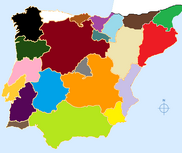| Republic of Lusitania Republica de Lusitania
| |||||
|---|---|---|---|---|---|
| |||||
 Map of Lusitania | |||||
| Capital and largest city |
Madrid | ||||
| Official languages | Spanish, Portuguese | ||||
| Recognised regional languages | Catalan, Aragonese, Basque and others | ||||
| Demonym | Lusitanian | ||||
| Government | Presidential Republic | ||||
• President |
Manuel Barroso | ||||
• Prime Minister |
Joan Manuel Serrat | ||||
| Establishment | |||||
• Republic |
15 August 1974 | ||||
| Population | |||||
• 2010 estimate |
78,000,000 | ||||
| GDP (PPP) | 2010 estimate | ||||
• Per capita |
$28,866 | ||||
| HDI (2010) |
0.929 very high | ||||
| Currency | Europan Lira (current) Euro (ex) | ||||
| Date format | DD-MM-YYYY | ||||
| Drives on the | right | ||||
| Internet TLD | .lu | ||||
The Republic of Lusitania is a nation in Iberia and on the Mediterranean sea. It is an important trading nation and is quite peaceful.
Geography[]
Lusitania is bordered in the north by France and the enclave of Andorra. In the south across the Straights of Gibraltar there is Morocco.

Provinces
Lusitania has 22 provinces and various territories (Occitan, Baleares, Azores, Madeira, Canarias and Cabo Verde). It is located on the Iberian peninsula, with some territory on the French Riviera. The largest mountains are the Pyrenees, which are in the north, near France.
The principal urban centres are: Madrid, Barcelona, Valencia, Sevilla, Zaragoza, Málaga, Lisbon, Bilbao, Alicante, Córdoba, Valladolid, Vila Nova de Gaia, Gijón, A Coruña, Porto,Granada, Elche, Oviedo, Braga, Coimbra and Setúbal. The main metropolitan areas and conurbations over a million are: Madrid, Barcelona, Lisbon, Valencia, Porto, Seville, Bilbao and Málaga
History[]
Romans history[]
In 219 BC the first Roman troops invaded the Iberian Peninsula, during the Second Punic war against the Carthaginians, and annexed it under Augustus after two centuries of war with the Celtic and Iberian tribes and the Phoenician, Greek and Carthaginian colonies, resulting in the creation of the province of Hispania. It was divided into Hispania Ulterior and Hispania Citerior during the late Roman Republic, and during the Roman Empire, it was divided into Hispania Taraconensis in the northeast, Hispania Baetica in the south and Lusitania in the southwest.
Germanics history[]
In the early 5th century, Germanic tribes invaded the peninsula, namely the Suevi, the Vandals (Silingi and Hasdingi) and their allies, the Sarmatian Alans. Only the kingdom of the Suevi (Quadi and Marcomanni) would endure after the arrival of another wave of Germanic invaders, the Visigoths, who conquered all of the Iberian peninsula and expelled or partially integrated the Vandals and the Alans. The Visigoths eventually conquered the Suevi kingdom and its capital city Bracara (modern day Braga) in 584-585. They would also conquer the province of the Byzantine Empire (552-624) of Spania in the south of the peninsula and the Balearic Islands.
Moorish history[]
In AD 711, a North African Moorish Umayyad army invaded Visigothic Christian Hispania. Under their leader Tariq ibn-Ziyad, they landed at Gibraltar and brought most of the Iberian Peninsula under Islamic rule in an eight-year campaign. Al-ʾAndalūs (Arabic الإندلس : Land of the Vandals) is the Arabic name given the Iberian Peninsula by its Muslim conquerors and its subsesquent inhabitants. From the 8th-15th centuries, parts of the Iberian peninsula were ruled by the Moors (mainly Berber and Arab) who had crossed over from North Africa. Cordoba was the greatest city in the Moorish Spain and one of the highest populated cities of the world.
Medieval history[]
Many of the ousted nobles took refuge in the unconquered north Asturian highlands. From there, they aimed to reconquer their lands from the Moors; this war of reconquest is known as the Reconquista. Christian and Muslim kingdoms fought and allied among themselves. The Muslim taifa kings competed in patronage of the arts, the Way of Saint James attracted pilgrims from all Western Europe, and the Jewish population set the basis of Sephardic culture.  In medieval times the peninsula housed many small states including Castile, Aragon, Navarre, León and Portugal. The peninsula was part of the Islamic Almohad empire until they were finally uprooted. The last major Muslim stronghold was Granada which was eliminated by a combined Castilian and Aragonese force in 1492.
The small states gradually amalgamated over time, with the exception of Portugal, even if for a brief period (1580–1640) the whole peninsula was united politically under the Iberian Union. After that point the modern position was reached and the peninsula now consists of the countries of Spain and Portugal (excluding their islands — the Portuguese Azores and Madeira Islands and the Spanish Canary Islands and Balearic Islands; and the Spanish exclaves of Ceuta and Melilla), Andorra, French Cerdagne and Gibraltar.
Modern history[]
Portugal became a republic in 1910 and removed its monarchy. In Spain, in 1936 the Civil War began, which last for three years and resulted in Francisco Franco becoming leader and dictator. In Portugal, the Estado Novo was created where António de Oliveira Salazar become the country's dictator.
Revolution[]
The Carnation Revolution started in Portugal on 25th April 1974. One week later there were also protests in Spain, where many people wanted Franco to be ousted. People protested greatly and on 11th May, Salazar was assasinated in Lisbon. The Portuguese and Spanish were making paramilitary groups to fight the governments and in July 1974 Franco left Spain and left for exile in the United States.
Unification[]
Treaty of Olivenza[]
This treaty was the final act which created the unification of the country's in 1976. Both provisional leaders of Spain and Portugal singed it at Olivenza
In 2012 Lusitania joined the S-E-L-S economic group.
Government[]
Lusitania's government is a republic, with a president and Prime minister, parliament and courts.
President[]
The President of Lusitania is the head of state of Lusitania. Manuel Barroso is the president of Lusitania. Presedents are elected every 4 years and can only be re elected once.
Prime Minister[]
The prime minister is the head of the government. The singer Joan Manuel Serrat is the Prime minister. Prime ministers are elected every 4 years along with representatives.
Cámara de Diputados[]
The Cámara de Diputados (Câmara dos Deputados) is the parliament of the nation where the Sentors and representatives meet. There are 78 Senators, 3 for each province and 2 for territories. They are elected every 4 years. There are also 208 represnetatives, for every electoral district, and are elected every 4 years. Poltical parties needed at least 5 % of the votes to get some seats.
Politics[]
There are various political parties in Lusitania that have been created since the 1970s. The Social Democrats and the Liberals are the most successful of all time, but recently Laranjas and Conservatives are doing better. The 2008 General Elections of Lusitania are the most recently elections.
Political parties[]
| Party name | position |
|---|---|
| Union Socialdemócrata | social democratic |
| Liberal Party of Lusitania | centre-left |
| Conservative Party of Lusitania | centre-right |
| Partido Nacionalista | ultra-right |
| Verde | enviromentalist |
| Centro Laranja | labour party |
| Partido Monarquista | right-wing |
Foreign relations[]
Lusitania is a country that likes European integrations. It has good relations with France, the Kingdom of Europa and Imperium Skandinavisk. It also wants to be on good terms with USSR. Lusitania views Yarphei with suspision because of its Communism and the East Asia Federation because corporations will only benefit themselves and not the people who need it. They are also worried of East Bulgaria because of it's violence to civilians.
Military[]
Lusitania does not have a big military, only 22000 soldiers and 15000 in reserve. There is a national police that is slowly replaceing the military.
Economy[]
Lusitania has the twelfth-largest economy in the world, based on nominal GDP comparisons, and the fourth-largest in Europe. It is regarded as the world's 20th most developed country. The economy of Lusitania has been regarded as one of the most dynamic within the EU, attracting significant amounts of foreign investment. Its economy had been credited with having avoided the virtual zero growth rate of some of its largest partners in the EU. In fact, the country's economy had created more than half of all the new jobs in the European Union. More recently, the Spanish economy had benefited greatly from the global real estate boom, with construction representing an astonishing 16% of GDP and 12% of employment in its final year. Energy and electricity is also big, with many wind farms located across the country.
Tourism[]
During the last decades Lusitania's foreign tourist industry has grown into the second biggest in the world and was worth approximately 40 billion Euros, about 5% of GDP, in 2006. The total value of foreign and domestic tourism came to nearly 11% of the country's GDP and provided employment for about 2 million people.
Manufacturing[]
Manufacturing of boats, Airplanes and cars is very large in Lusitania. Companies like European Aerospace, Fiat Group, Daimler Mercedes-Benz, Ford, Renault, GM/Opel, PSA Peugeot/Citroën, Iveco, Chery etc. - have facilities and plants in Lusitania today developing and producing vehicles and components, not only for the needs of the internal market but also for exportation purposes, with the contribution of the automobile industry in 2008 rising up to the second place with 17,6% out of the country's total exports.
Culture[]
Sports[]
Football is the largest and most popular sport in the country. The Liga SEAT is the top division. The most sucessful teams are FC Barcelona, Real Madrid and FC Porto.









